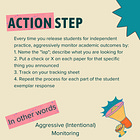Action Step of the Week: Exit Tickets
It's one of the most important routines to establish. Do it at the beginning of the year.
Action Step of the Week
At the end of every class period, assign a 2-3 question exit ticket:
Find the exit ticket or assessment provided by the curriculum
Set a time to assign the exit ticket
Circulate to monitor, providing minimal assistance
Why?
Exit tickets are considered a strong instructional strategy because they offer multiple, research-backed benefits that enhance both teaching and learning:
Immediate Formative Assessment: Exit tickets provide teachers with real-time, authentic data on student understanding at the end of each lesson, allowing for quick adjustments to instruction based on student needs.
Promotes Student Metacognition: Requiring students to reflect on what they learned fosters metacognitive skills.
Enhances Student Engagement and Accountability: Regular use of exit tickets increases student engagement and participation, as all students are expected to contribute feedback or demonstrate understanding, not just the most vocal ones.
Flexible and Efficient: Exit tickets are highly adaptable—they can be used in any subject, at any grade level, and can be delivered in various formats (paper, digital, group, or individual). They require minimal class time.
Why Exit Tickets with Novice Teachers EARLY?
Exit tickets offer a strategic entry point for coaching new teachers because they blend foundational routines with instructional clarity. Since we only tackle one thing at a time and new teachers need so much, this is a wham-bam action step that solves lots of problems.
This immediately helps teachers understand:
What mastery looks like—Teachers define clear criteria for success by creating a strong exemplar for the exit ticket.
How to design purposeful practice—Teachers clearly see what students need to practice during lessons, ensuring alignment between instruction and assessment.
The power of rapid feedback—Teachers learn to quickly review exit tickets and adjust teaching, gaining practice in agile, responsive instruction.
Plus, introducing exit tickets early creates simple, structured classroom routines, reinforcing effective management and helping new teachers rapidly establish a classroom culture of accountability and clarity.
You can see where this shows up in Get Better Faster (and now there’s a 2.0!!!) coaching model. It’s near the top.
Potential Evidence
The teacher is flying blind; time between assessments is too long.
Students lack investment, accountability, or feedback.
The teacher struggles with creating aligned lesson plans; doesn’t understand objectives.
Questions to Ask Yourself
What percentage of students mastered the lesson’s objective?
What does mastery look like for this lesson objective?
What are the students’ actual responses? Does it match the exemplar?
What is the level of difficulty of this task for the students?
Is this even the best objective to select given where these students are?
How invested are the students? Do they know what their goal is for this class? This lesson?
Glossary of Terms
Exit Ticket: A short, formative assessment given at the end of a lesson to gauge students’ understanding, inform future instruction, and reinforce routines.
Formative Assessment: Quick checks (like exit tickets) used during or after instruction to gather immediate feedback on student learning, guiding instructional decisions.
Exemplar: A model or sample answer created by the teacher that demonstrates exactly what mastery of the exit ticket should look like.
Aggressive Monitoring: A strategy of quickly and purposefully reviewing student responses in real-time or immediately after completion to inform immediate instructional adjustments.
Data-Driven Instruction (DDI): Instructional planning and teaching decisions made explicitly based on the insights gathered from student responses on exit tickets.
Coaching Conversation Template
How to use it:
Find any bracketed text.
Fill this in BEFORE you meet with the teacher. You will look silly and I would feel sad. Only use ONE of the evidence examples.
Be you! You can do it. The best coaches are planned coaches.
Praise/Follow Up on Previous Action Steps
I appreciate the opportunity to sit down with you to discuss my observation.
First, I want to follow up on <previous action step or feedback>. Tell me more about how this is going for you. What impact has this had on you and your students?
Today, I saw <positive evidence of specific teacher action>.
What impact does this move have on you and your students?
Evidence
I want to hone in on some evidence I collected when I was in your classroom.
<flying blind> (i.e. Before we get to specifics, I am curious. How do you know whether students mastered today’s lesson? What are you looking for? Could you name a percent of students that mastered it? That’s my challenge to you. We need an assessment measure for today. Here’s why I say this. Today, I saw you nail this awesome lesson and at the end, I could say with confidence that 4 students mastered it because I was staring at their paper. I’m not sure about the other ones. See what I mean?)
<lack of student investment/accountability> (i.e. One of the things we talked about previously was the challenge of student investment and I saw some evidence of that today. In fact, throughout today, I noticed about 60% of students had to be reminded to work and you were asked 4 times if it was a grade. I want to offer you a strategy that will really help build some investment towards learning rather than the extrinsic motivator of grades. Do you have a classroom-based goal related to student mastery? Is that posted anywhere?)
<aligned lesson plans> (i.e. Today, I saw you teach about the Industrial Revolution, which is clearly outlined in standard 2.1. Let’s look at that standard for a second. In today’s lesson, what activities or tasks aligned to that specific standard? The challenge was alignment. I could clearly see your intention with these activities but it wasn’t perfectly aligned. I want to get us on a track to help get these lessons more aligned to standards by starting with exit tickets. How does that sound?)
Action Step
Great, so here is your action step: At the end of every class period, assign a 2-3 question exit ticket:
Find the exit ticket or assessment provided by the curriculum
Set a time to assign the exit ticket
Circulate to monitor, providing minimal assistance
Go ahead and write down the action step.
What impact do you see this happening in your classroom?
Plan/Practice
Let me show you what this looks like with the lesson that I observed.
MODEL
For the lesson I observed, I <found/created> this exit ticket. Let me explain. The standard says <standard>. Let’s do a quick check of alignment. Notice the exit ticket is really short. Now, I’m going to show you what it looks like in the classroom.
“Pencils down and eyes on me in 3…2…1… Time is up for independent practice. I know you are feeling confident and it’s time to prove what you know. You will have 5 minutes to complete the exit ticket independently. When you finish, you will turn your exit ticket over so I can do a quick visual check. If I feel you have put in the effort to show what you know, I will ask you to put your exit ticket in the bucket where you think you are. Green bucket if you feel confident and yellow or red bucket if you are feeling not so great about it. Voices are off the whole time. Go.”
Model walking and monitoring.
What did you see in my model that is present in the action step?
PLAN
Let’s practice this for tomorrow. Let’s start by planning your exit ticket. Let’s do a check of alignment to the standard. What is effective about this exit ticket you wrote? What makes you nervous so far?
PRACTICE
Part 1: Now, let’s practice execution. I’ll play the students. Go ahead and introduce the exit ticket.
Look for:
Exit ticket is short and aligned
Clear procedure for completion and turn in
Formal register/tone
Clear directions
Monitoring the room
Body language
Closing/Follow Up
Thanks for playing along. I know practice can be awkward, but it is a great way to ensure we can work out all the kinks.
Let’s review the action step.
To follow up, I would love to see this in action and so we can work out all of the kinks. I look forward to seeing you in action <date>.
More great action steps for the beginning of the year (If you need any of these things and you are not a paid subscriber, please reach out. I’ll open it up for you. I never want to gatekeep learning).









